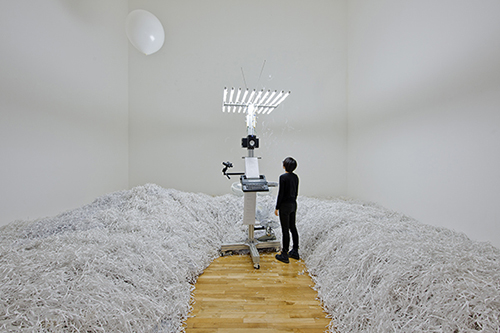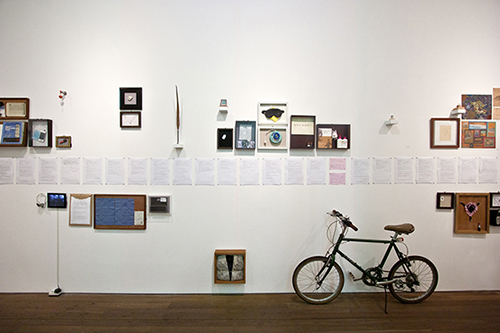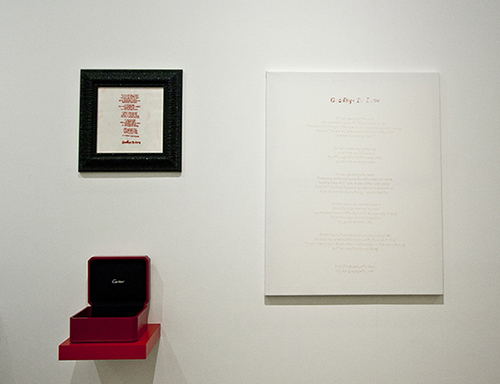Park Hyesoo finds present and future of human in artworks
An art graduate in her twenties walks into the woods, a big log on one hand and a magnifying glass on the other. She is chasing the sun to burn the log's annual rings by using magnifying glass. She keeps walking, with the heaviness of equipment, sun and life. She never knew an hour’s work would take her an entire year. Finally Park Hye-soo (’97 Sculpture) completed "Time for Depth (2004)" and made her official debut as an “artist?

Time for Depth_ 2002~2003_burned wood with magnifying glass _50×40×30cm(wood)
The incidence just explains the unique art world of the winner of Song Eun Art Award (2014), an award held by SongEun Culture Foundation which nominates talented artists and support them to hold free exhibition for two weeks in SongEun Art Space. However, her own view on art is not a one night’s work. After graduating university, she went to graduate school (’00, Sculpture) to further study the field. Then she worked as a high school art teacher in the thinking that she is just a common art graduates among a flood of talented young artists. However, after all these years trying various kinds of art-related works, she decided to become an “artist” believing it is the heart of the art world, who originates and give existence to something.
What inspires Park and how she makes them into artworks
Park did many projects concerning dream and love. What is special about this project is that the artist herself does not perfectly understands her art work, because it is not only about herself, but also about the audience.
“I want to throw questions to the public and let them figure out something about their lives,” Park said.
“Sometimes when I do not know about a subject in depth, I ask for help to the professionals.”
As Park said, her projects are not to show, but to be some tipping points of the life of audience. To do this, she needed more specific and realistic approach. She once sat in a cafe and happened to eavesdrop on people’s conversations who sat next to her table, which in turn became the subject of her art piece.
“The weird part was that there were ten different groups that had sat on the next table talking thousands and millions of words,” Park said. “The conversations all sounded different but they all had similar patterns.
As I listen, I got a feeling that people do not speak out what they have deep inside of heart. They do not talk of difficult, tough or embarrassing subjects but instead spend time talking of something they are not really interested in.” Park said people liked to talk of money, love or someone they had in mind.”
“However, there was a conversation that did struck me,” Park said.
“Two high school boys were worrying about their future and lamenting for their dream. Not to mention their content of conversation, I cannot ever forget their faces, as if a five-year-old saying ‘I’m bored of life.’”
Then, some flood of thoughts and emotions coursed through Park’s mind. “Suddenly, I felt a sense of responsibility as a member of older generation. I thought what and who on earth had made their future so dark, and then I decided?“dream” as the first subject of my project which became “Project Dialogue Vol.1- Dream Dust”
In this project she collected abandoned yet unattainable dreams from the conversations of public and helped people to let them go away by writing them on the papers and putting in paper shredders.

Dream Dust_2011_shredded research paper, paper-shredder, fluorescent light_variable dimensions
As aforementioned, not only what people have in mind inspires Park, something that the public owns becomes the art piece itself sometimes. For “Project Dialogue Vol.3- Goodbye to Love,” Park collected things people got from past or failed loves and named them as “The Broken Hearted Collection.”

Archive ' the Broken Heart Collection' (2013)_MoA Museum(Seoul, KR)
Park has been collecting “objects” from the broken heart since April 2013 and held the exhibition until September in Museum of Art Seoul National University. The exhibition presented donated or loaned “objects” along with their own heart-wrenching stories. The “objects” include portrait, necklace, underwear, perfume, dolls, phone and so on. They showed emotional, sad, confusing and sometimes abnormal sides of love.
“Most impressive object sent to me for the collection was a clock a divorced woman received as wedding present,” Park said. “It was sent along with the story that she got married not because of affection, but due to the age and the fantasy that marriage gave her.”

Goodbye to Love_2012_needle work on canvas, sound, red thread_variable dimension
Park ponders over present and future through what is abandoned. “I believe we can find our way for the present and future in the past,” Park said. “Humans can make same mistakes but I try to make better choice and be a better human being. People can find that choice in the lives of others.”
Parks’ outlook on life and her lifetime advices for Ewha students
Living as a female artist, Park acknowledges the discrimination that society poses against female artists.?“‘Something does not change just never changes’ will be the right expression for the hardship as 'female' artist," Park said. However, she especially wants to share biased view of the field upon Ewha graduates.
"Artists who graduated from Ewha including me want to be perfect at work. Furthermore, they have this idea that they should not do harm to others, which in turn make them hard to socialize." Park said.
"I wonder why we tried that hard to just show we are perfect. We could have just shown a little bit of clumsy and imperfect selves and open up for cooperation." She added that students these days are afraid of making mistakes.
"Do not stuck and shut yourself in the room to be a perfect girl. Get mixed up with all kinds of people and experience various worlds."?
Young people these days give up love and dream for realistic reasons, or sometimes because of “normal” standard society set upon them. Park advises on university students what she learned during her years as an artist.
“People give up life for success and family for fame.” Park said.
“The interesting fact, however, is that after we get successful, we use much greater amount of time and money to get those back. People want to be famous and successful in the first place because they want people to care about them.”
Park doubts that those feelings of love and care that are bought back cannot be as pure and genuine as that of the early years.
Also, she emphasizes the importance of being able to feel and to enjoy in young age, for feeling and emotions cannot be earned by years of experience and life being stable.
“Your life is too short and precious just to present it to the others or to your parents,” Park said.
“Do not fumble on others to make sure you are alive. Believe your own breath and footprints. Walk on.”
-EWHA Voice (English language news paper in EHWA Womans Univ)